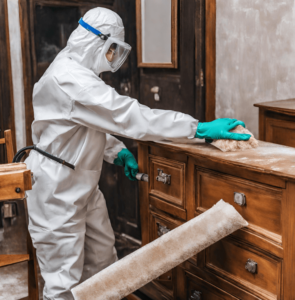The Process of Hoarding and Squalor Cleaning Services
The Process of Hoarding and Squalor Cleaning Services
Hoarding is the practice of amassing an excessive number of possessions in one’s living area. This behaviour can result in living conditions that are unsafe and can have a negative influence on the hoarder’s as well as their loved one’s physical and mental health. Squalor is a term that describes living conditions that are unclean, cluttered, and present a risk to one’s health for individuals who occupy the place. Because hoarding and squalor may have a severe impact on both the hoarder and the hoarder’s loved ones if they are not treated, it is crucial that hoarding and squalor services be provided by trained professionals in Melbourne.
The process of cleaning up after someone hoards is a multi-step process that includes decluttering, deep cleaning, disinfecting, and getting rid of hazardous rubbish. This article will provide a detailed walkthrough of the process of the hoarding and squalor cleaning services offered by AllAces in Melbourne.
Step 1: Assessment
The initial stage in the process of cleaning up after a hoarder is to do an evaluation of the living space to identify the severity of the hoarding issue. Hoarding experts from AllAces Melbourne will pay a visit to the residence to evaluate the living conditions and determine whether or not there is any hazardous rubbish that needs to be removed. This phase is essential to the process of formulating a strategy for decluttering the living space and cleaning the home.
Step 2: Eliminating Clutter
Getting rid of clutter in the living area is the second phase in the process of cleaning up after a hoarder. Professional hoarding cleaners from AllAces Melbourne are aware that the items that are being accumulated have sentimental importance to the hoarder. Because of this, they treat each hoarding clean-up with delicacy and respect for both the hoarder and their belongings. They collaborate with the hoarder to design a strategy for clearing the living area and to identify objects that can be discarded in a manner that is not hazardous. This phase is essential in the process of producing a living environment that is both more secure and better organised.
Step 3: Deep Cleaning
Following the decluttering of the living space, the following stage is to give the home a comprehensive cleaning. Professional hoarding clean-up technicians from AllAces Melbourne make use of specific tools and methods to conduct in-depth cleaning of living spaces. This helps to ensure that all surfaces are disinfected and that any potentially dangerous material is disposed of in an appropriate manner. This phase is essential in enhancing the health and safety of the living environment, lowering the risk of disease transmission, and boosting overall well-being.
Step 4: Disinfecting and Sanitising
After doing a thorough cleaning of the living space, AllAces will then cleanse and disinfect all of the surfaces, including the walls, the floors, and the furniture. This phase is essential in the process of eradicating any dangerous bacteria, viruses, and germs that might be present in the living environment.
Step 5: Hazardous Waste Removal
The elimination of potentially harmful waste is the final stage of the hoarding cleanup process. Professional hoarding cleaners AllAces are equipped with the knowledge and tools necessary to securely remove hazardous material, such as biohazards, chemicals, and electronic trash, and dispose of it in a manner that is both safe and responsible. This step is essential for ensuring that the living environment is safe and lowering the chance of being exposed to potentially dangerous substances and materials.
In conclusion, hoarding and squalor are both complicated problems that must be tackled in a methodical manner if they are to be resolved. When it comes to decluttering, deep cleaning, disinfecting, and eliminating dangerous waste from the living area, hoarder cleaning services from AllAces Melbourne play a pivotal role. We understand the complexities associated with hoarding and filth, and we tackle the cleaning up of hoarding situations with sensitivity, respect, and expertise.
FAQs
1. What is the Difference Between Hoarding and Squalor?
Hoarding and squalor are both conditions that involve issues related to cleanliness, organisation, and clutter, but they are distinct in their underlying reasons and manifestations. Hoarding is a psychological disorder characterised by the excessive acquisition of items and an inability to discard them, even when they have no value or utility. Squalor, on the other hand, refers to extremely poor and unsanitary living conditions, which can arise from a variety of factors like mental illness, physical disability, or neglect. Hoarding can lead to squalor, but they are not synonymous.
2. Are Hoarding and Collecting the Same Thing?
No, hoarding and collecting are not the same. Collectors usually have a specific focus and take pride in organising and displaying their collections. They also don’t experience significant distress or impairment in their daily lives due to their collecting activities. On the other hand, hoarders acquire a wide range of items, often of little value, and allow them to clutter their living spaces. This leads to distress and can impair their ability to function normally in daily life.
3. What are the Health Risks Associated with Living in Squalor?
Living in squalor poses various health risks, including the potential for bacterial and viral infections due to unsanitary conditions. There may also be hazards related to mould growth, pest infestations, and poor air quality. The clutter and disorganisation can result in accidents, such as tripping or falling. Additionally, the stress and anxiety caused by living in such conditions can have detrimental effects on mental health.


